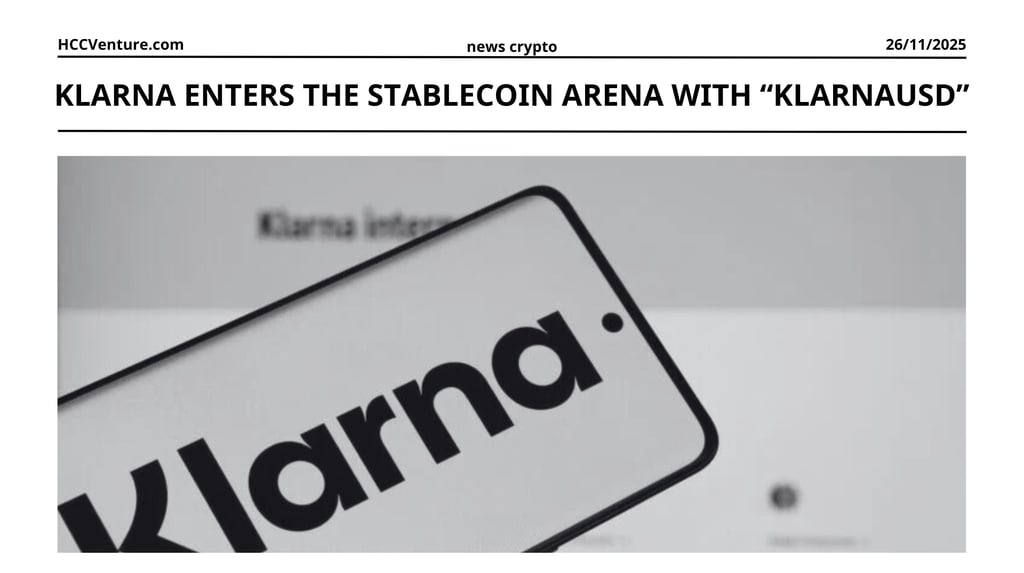Klarna Enters the Stablecoin Arena with “KlarnaUSD”
Klarna, the Swedish buy now, pay later (BNPL) giant that serves 114 million customers and processes $112 billion in gross merchandise value (GMV) annually, has entered the stablecoin market with the announcement of KlarnaUSD.
11/26/20252 min read


Performance backed by USD
Klarna’s surprise announcement of its own stablecoin, KlarnaUSD, has immediately sent ripples through both the fintech and cryptocurrency markets. As one of the largest “buy now, pay later” (BNPL) platforms with tens of millions of global users, Klarna’s decision is more than just an experiment by the company.
This signals a strategic realization that traditional payment methods can no longer meet the scale or speed required by modern digital commerce.
The launch places Klarna at the intersection of fintech and blockchain infrastructure, and has the potential to spur a broader shift in cross-border payments from traditional networks to stablecoin-based payments.
Why is Klarna moving to Stablecoins?
The timing of Klarna’s entry is no coincidence. The BNPL economy has tightened due to rising global interest rates, forcing companies like Klarna, Afterpay and Affirm to re-examine their operational efficiencies. Payment processing and foreign exchange fees significantly erode profit margins, especially for a business that relies on high transaction volumes with tight spreads.
As a result, KlarnaUSD emerged as a direct response to these pressures: a blockchain-based payments layer that can cut cross-border payment costs while providing real-time settlement features and programmable compliance.
Instead of relying on Visa, Mastercard, or SWIFT, Klarna is positioning itself to internalize part of the payments stack—a move reminiscent of how PayPal launched PYUSD to improve its own unit economics.
Competitive pressure on traditional payments
Klarna’s move poses a strategic threat to Visa, Mastercard and other major cross-border processors. While these have embraced stablecoins as a niche fintech tool, Klarna’s scale increases the risk.
The real danger isn't that consumers will abandon card payments, but that merchants and fintechs will build their own payment environments, bypassing card networks altogether.
KlarnaUSD demonstrates that stablecoins are evolving from native crypto instruments into enterprise utilities—a trend that could reshape the global payments economy in the same way cloud computing has reshaped enterprise IT.
Disclaimer: The information presented in this article is the author's personal opinion in the cryptocurrency field. It is not intended to be financial or investment advice. Any investment decision should be based on careful consideration of your personal portfolio and risk tolerance. The views expressed in this article do not represent the official position of the platform. We recommend that readers conduct their own research and consult with a professional before making any investment decisions.
Explore HCCVenture group
HCCVenture © 2023. All rights reserved.


Connect with us
Popular content
Contact to us
E-mail : holdcoincventure_contact@hccventure.com
Register : https://linktr.ee/holdcoincventure
Disclaimer: The information on this website is for informational purposes only and should not be considered investment advice. We are not responsible for any risks or losses arising from investment decisions based on the content here.


TERMS AND CONDITIONS • CUSTOMER PROTECTION POLICY
ANALYTICAL AND NEWS CONTENT IS COMPILED AND PROVIDED BY EXPERTS IN THE FIELD OF DIGITAL FINANCE AND BLOCKCHAIN BELONGING TO HCCVENTURE ORGANIZATION, INCLUDING OWNERSHIP OF THE CONTENT.
RESPONSIBLE FOR MANAGING ALL CONTENT AND ANALYSIS: HCCVENTURE FOUNDER - TRUONG MINH HUY
Read warnings about scams and phishing emails — REPORT A PROBLEM WITH OUR SITE.
